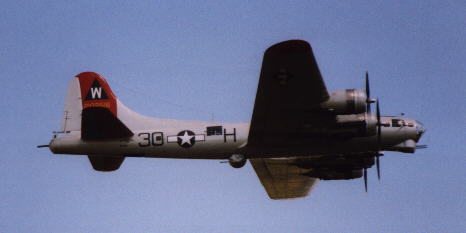
Taxiing for take-off.

Take off roll.
At the end of the taxiway he paused while other planes entered the landing pattern and waited for them to put down. Several minutes passed before the pattern was clear. Again the pilot ran the engines up to full throttle, made his last checks then moved onto the runway. The pilot pushed the throttles up to full and the 17 started its take off roll.

The rest of us waited as the pilot flew around the field.
I tried to imagine how an airfield would sound. The 17 didn't seem as loud as I had imagined (a false perception.) Then again, this was just one bomber. A base launching 30-40 airplanes would have sounded very different. The Wright Cyclone engines were grabbing the air and pulling the bomber down the runway. With no bomb load and only 1,000 gallons of gas, the Aluminum Overcast was airborne in 3,000 feet. Watching this bomber take off was a great sight!

Radio Transmitter.
Distance muted the sound. Here too I tried to imagine the sound of 3 dozen bombers flying in formation overhead. It had to be a breath taking sight, the sound unforgettable. Unfortunately, I would never know.
The second flight would take off without me too. As I waited for my turn, I surveyed the "crew" I was going to be flying with. I was the tallest and the youngest (43.) We weren't thrill seekers just out to get our kicks; rather, we were here to experience something from our recent history, to understand what it must have been like. Boyish grins flashed across these expectant faces. Finally, it was our turn. One final briefing and we boarded through the waist hatch.
I had to be careful climbing aboard. It was going to be cramped and I didn't want to bang my head on any obstruction. Getting through the hatch was easy enough, but I had to make my way forward in a crouch. The ribs of the bomber hung at forehead level and I didn't want any painful souvenirs. I wore a ball cap to minimize any tearing of my scalp, but I was wishing for a flak helmet!
To get into the radio compartment I had to get around the ball. Not difficult in a stationary aircraft as long as you were careful. But, I suspected it presented a big obstacle in an emergency in the air when the aircraft was bouncing around.
Copyright © 1998-2025, 486th Bomb Group Association.